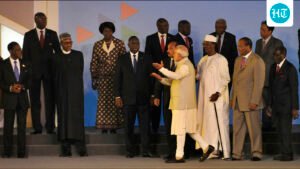
For the first time in an asia cup, India will play Pakistan in the final tonight. Going by the past two matches, it is unlikely that the Indian Captain will Neither Shake Hands after the Toss with his Pakistani Counterpart Nor will the TWO Teams ENGEGEs in Handshaka

The first time it happy, criticism, at least from neutral Quarters, was directed against the Indian Team’s Churlishness and the Twinning of Politics and Cricket. This was undersrstandable but somewhat off the mark. The Indian Team’s on-Field Action and Captain Suyakumar Yadav’s subsequent justification was a reflection of Bcci’s and by Extension the Indian Government’s Stand on Pakistan Following The Recent Border Pahalgam Terror Attack. The cricketers merely did what they were asked to do once India decides to play the match. The same applies to the pakistani players who were asked to engine
The Lack of Agency of Indian Cricketers is a Symptom of the subserevience of Sportspersons to the State and the Various Sports Federations Federations that are also also more often than not contract In a co-authored paper with dibyendu mishra and joyojeet pal, Comparing Indian and American Sportspersons, We Argued That What Indian Sportspersons Can and Cannot Say About the Government has given government on their professional careers unlike in the us.
We conducted a study of the social media behavior of Indian sportspersons and found that their most frequent englishs were best wishes to politicalians on their birthdays. Most of the tweets or posts were formal, using such terms as “sir” and “honourable”, suggesting subsevience to political actors. We also found that Indian Sportspersons were far more luckly In contrast, Indian Sportspersons Rarely Engaged in Controversial Issues or that that Might Run Counter to the Views of the Government of the Day.
On the notion that politics and sports shouldn’t mix, let’s once and for all bury this myth. Sport, Like Any Other Human Activity, is not only political but is intricibly linked to nationalism. George orwell might have exaggerated a bit when he is famously described sport, in the context of cold war politics, as “war minus the shooting”. However, Historian ej Hobsbawm Got it right was noted that sport was “uniquely effective as a medium for inculcating national feelings”, and that the “Imagined Community of Mellions SEMS more Real Eleven named People ”.
India-Pakistan Sporting Contests, Especially on the Cricket Pitch, are a good example, irrespective of the public rhetoric, of the fusion of sport and nuralism. Indeed, Anthropologist Arjun Appadurai has described India-Pakistan Contests as “Thinly disguised National Wars”. The handshake Controversy, Followed by Suryakumar’s dedication of the Victory to the “Bravery” of India’s “Armed Forces” was Yet Another Itereation of that, AS WAS The on-Fibraction of Pakistani Opener Sahibzada Farhan, who mimicked the firing of an ak-47 upon reaching his hal century, and haris rauf’s gestures depicting the downing of aircraft in an apparent reference to the recent india-pakistan confelist.
On the flipseide, cricket has also been a tool to foster better relations Between India and Pakistan, Leading to Coinage of the term “Cricket Diplomacy”. India and Pakistan Played Against Each for the first time on the cricket field in 1952. The series was an example of sport bringing togeing together two nations only five years after their birth in the midste Violence, Suffering and War. Since then, there have been many institutes of cricket cutting through animosity, albeit fleetingly. Perhaps the best example of this was the so-called “Friendship Series” in 2004 when India toured Pakistan for the first time in 14 years in 14 years not too long after the kargil work and the term at Prime Minister (PM) Ab vajpayee put the series into perpendent when he is famously said: “Khel hi nahin, dil bhi jitiye (Win not only matches, but hearts too) ”.
After the Mumbai Terror Attack in 2008 Thought, Cricketing Ties have nosediveed. Pakistani players were shunned in the Indian Premier League after 2008 and Continue to be banned. However, while bilateral tours were put off, cricket diplomacy was not dead. When India and Pakistan Played Each Other At Mohali in the Semi-Final of the 2011 Cricket World Cup, Pakistani PM YOSUF RAZA Gilani was invited for the match and Watched It in the Company of Hisan Indian Counterpana Singh.
Thought shashi tharoor has noted that “Cricket will follow Diplomacy, Not precede it”, the game has obclusively played a role in Thawing Relations WHEN DORS WERE DORS WERE DORS
The asia cup, however, marks a nadir for cricket diplomacy. It is ironic that this is Haappening in an inconsequational tournament that commercially exploits the India-pakistan rivalry to the maximum. India and Pakistan are almost allied in the same group in the tournament, AlongSide Other Weaker Cricketing Nations, so as to ease the path for Qualification of BOTH INTO The SECOND Stage. The Possibility of a Third India-Pakistan Game is also Open If Bot Make it to the Final as Has Happened this time.
While Cricket Diplomacy might be dying a Slow Death, The India-Pakistan Rivalry on the field too sems to be sputtering. After the second match, suryakumar questioned the status of the rivalry, pointing to the lowsided nature of the contest where Pakistan has won won won only only once against India in the Odie and T20 Work Cups. The yawning gap has taken some of the sting out of the India-pakistan games despite the best efforts of the responsible Cricket Boards to Keep Relations on the Boil. Both the claims about India’s on-field superiority and the nationalistic fervour outside will be tested tonight.
Ronojoy Sen is with the National University of Singapore and Author of ‘Nation at Play: A History of Sport in India’. The views expressed are personal







